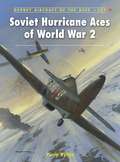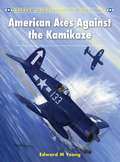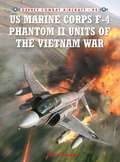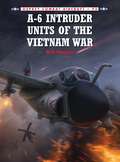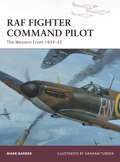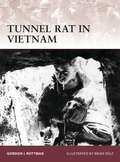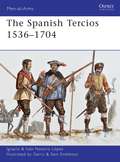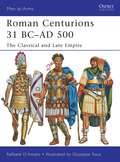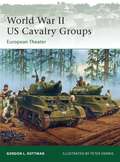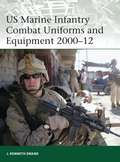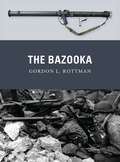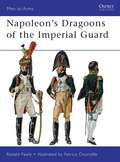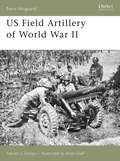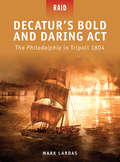- Table View
- List View
Soviet Hurricane Aces of World War 2 (Aircraft of the Aces #107)
by Aleksander Rusinov Yuriy RybinFollowing the destruction wrought on the Red Army Air Forces during the first days of Operation Barbarossa in June 1941, the Soviet Union found itself desperately short of fighter aircraft. Premier Josef Stalin duly appealed directly to Prime Minister Winston Churchill for replacement aircraft, and in late 1941 the British delivered the first of 3360 Hurricanes that would be supplied to the Soviet Union under the Lend-Lease agreement. Specifically requested by the USSR, the Hurricanes were quickly thrown into action in early 1942 – the Soviet Air Forces' most difficult year in their opposition to the Luftwaffe. Virtually all the Hurricanes were issued to Soviet fighter regiments in the northern sector of the front, where pilots were initially trained to fly the aircraft by RAF personnel that had accompanied the early Hawker fighters to the USSR. The Hurricane proved to be an easy aircraft to master, even for the poorly trained young Soviet pilots, allowing the Red Army to form a large number of new fighter regiments quickly in the polar area. In spite of a relatively poor top speed, and only a modest rate-of-climb, the Hurricane was the mount of at least 17 Soviet aces.
P-38 Lightning Aces of the 82nd Fighter Group (Aircraft of the Aces #108)
by Chris Davey Steve BlakeWhen the 82nd Fighter Group was organized in March 1942, most of its initial pilot cadre was comprised of newly graduated staff sergeant pilots of Class 42-C – enlisted men! They learned to fly the P-38 at Muroc, in California's Mojave Desert, and then moved to the Los Angeles area to continue their training and to serve as part of its air defence. In September 1942 the group was transported to the East Coast, from where it shipped out to Ireland on the Queen Mary. By this time all its remaining sergeant pilots had been commissioned. As of VE-Day the 82nd Fighter Group's score of confirmed aerial victories stood at 548 aircraft shot down, plus a huge amount of enemy materiel – including aircraft – destroyed on the ground and the sea. It had been awarded three Distinguished Unit Citations. The cost of this success was high, however, for around 250 of the group's pilots had either been killed in action or captured.
American Aces against the Kamikaze (Aircraft of the Aces #109)
by Mark Styling Edward M. YoungThe Japanese High Command realised that the loss of Okinawa would give the Americans a base for the invasion of Japan. Its desperate response was to unleash the full force of the Special Attack Units, known in the west as the Kamikaze ('Divine Wind'). In a series of mass attacks in between April and June 1945, more than 900 Kamikaze aeroplanes were shot down. Conventional fighters and bombers accompanied the Special Attack Units as escorts, and to add their own weight to the attacks on the US fleet. In the air battles leading up to the invasion of Okinawa, as well as those that raged over the island in the three months that followed, the Japanese lost more than 7,000 aircraft both in the air and on the ground. In the course of the fighting, 67 Navy, 21 Marine, and three USAAF pilots became aces. In many ways it was an uneven combat and on numerous occasions following these uneven contests, American fighter pilots would return from combat having shot down up to six Japanese aeroplanes during a single mission.
Austro-Hungarian Albatros Aces of World War 1 (Aircraft of the Aces)
by Harry Dempsey Paolo VarrialeAustro-Hungarian industry produced a series of poor fighter types such as the Phönix D I and Hansa-Brandenburg D I during the early stages of the war, and it was not until licence-built examples of the battle-proven Albatros and D II and D III began to reach Fliegerkompagnien, or Fliks, in May 1917 that the fortunes of pilots began to look up. Unlike the German-built Albatrosen, the Oeffag aircraft were far more robust than German D IIs and D IIIs. They also displayed superior speed, climb, manoeuvrability and infinitely safer flight characteristics. The careful cross-checking of Allied sources with Austrian and German records form the basis for a detailed reconstruction of the dogfights fought by the leading aces. It will also chart the careers of the Austro-Hungarian aces that flew the D II and D III, their successes and their defeats, with additional information about their personal background and their post-war lives in the nations born from the collapse of the Hapsburg Empire.
US Marine Corps F-4 Phantom II Units of the Vietnam War (Combat Aircraft)
by Jim Laurier Peter E. DaviesTwenty-five US Marine Corps squadrons flew versions of the Phantom II and 11 of them used the aircraft in South-East Asia from May 1965 through to early 1973. Rather than the air-to-air missiles that were the main component in the original F-4 armament, these aircraft carried an ever-expanding range of weaponry. Some toted 24,500-lb bombs and others strafed with up to three 20 mm gun pods, while most flew daily sorties delivering napalm, Snakeye bombs and big Zuni rockets. Many US Marines holding small outpost positions in Laos and South Vietnam against heavy Viet Cong attack owed their lives to the Phantom II pilots who repeatedly drove off the enemy. The book will examine these missions in the context of US Marine Corps close-support doctrine, using the direct experience of a selection of the aircrew who flew and organised those missions.
Valiant Units of the Cold War (Combat Aircraft #95)
by Chris Davey Andrew BrookesThe RAF's first Cold War strategic bomber, the Vickers Valiant, was procured as an insurance measure in case either the Vulcan or Victor was found to have a serious flaw. The Valiant was the equivalent of the US B-47 Stratojet, and it blazed the trail for the British airborne nuclear deterrent as the aircraft enjoyed a far more active service career than later V-bombers. It was the launch platform for all British free fall nuclear weapons tests both in the Pacific and in central Australia, it took part in the Suez campaign in 1956 and it was the only V-bomber to drop (conventional) weapons in anger until the Falklands operation in 1982. The Valiant was modified to serve in the electronic warfare, strategic reconnaissance and airborne tanker role, but it had to be grounded in early 1965 when the aircraft succumbed to metal fatigue.
A-6 Intruder Units of the Vietnam War (Combat Aircraft)
by Jim Laurier Rick MorganDesigned in the years following the Korean War and then manufactured for over 30 years starting in 1960, the A-6 quickly became the most capable attack aircraft in the US Navy's stable. The first squadron, VA-75, made its initial deployment directly into combat in south-east Asia in 1965, and, over the next eight years, ten US Navy and four Marine Intruder squadrons would conduct combat operations throughout Vietnam, Laos and Cambodia. After initial problems and a high loss rate, the type proved itself beyond all doubt as the Naval services' best night and foul-weather platform, particularly during the region's notorious monsoon season. The A-6 Intruder became a true classic of naval aviation over the skies of North Vietnam but the cost was high as 69 Intruders were lost in combat to all causes during the war. This work tells the complete story of these aircraft in combat during the Vietnam War.
Avenging Angel: John Brown’s Raid on Harpers Ferry 1859 (Raid)
by Ron Field Johnny Shumate Alan Gilliland Mark StaceyThe Harpers Ferry raid confirmed for many Southerners the existence of a widespread Northern plot against slavery. In fact, Brown had raised funds for his raid from Northern abolitionists. To arm the slaves, he ordered one thousand pikes from a Connecticut manufacturer. Letters to Governor Wise betrayed the mixed feelings people held for Brown. For some, he was simply insane and should not be hanged. For others, he was a martyr to the cause of abolition, and his quick trial and execution reflected the fear and arrogance of the Virginia slave-owning aristocracy. Many Northerners condemned Brown's actions but thought him right in his conviction that slavery had to end. John Brown's raid on Harpers Ferry and his subsequent execution further polarized North and South and made a solution of the slavery issue central to the national debate which ultimately led to Civil War in 1861.
The Sten Gun (Weapon)
by Leroy Thompson Mark Stacey Alan GillilandThe Sten submachine gun – officially the 'Carbine, Machine, Sten' – was developed to fulfill the pressing British need for large quantities of cheaply produced weapons after Dunkirk, when German invasion was a very real possibility. Over four million were built during World War II, and the Sten was widely used by airborne troops, tankers, and others who needed a compact weapon with substantial firepower. It proved especially popular with Resistance fighters as it was easy to conceal, deadly at close range, and could fire captured German ammunition – with a design so simple that Resistance fighters were able to produce them in bicycle shops. Featuring vivid first-hand accounts, specially commissioned full-colour artwork and close-up photographs, this is the fascinating story of the mass-produced submachine gun that provided Allied soldiers and Resistance fighters with devastating close-range firepower.
The Browning Automatic Rifle (Weapon #15)
by Johnny Shumate Alan Gilliland Robert R. Hodges Jr. Robert R. HodgesFor nearly fifty years the hard-hitting, mobile Browning Automatic Rifle, or BAR, served in US infantry units as a light squad automatic "base of fire†? weapon, providing quick bursts of concentrated fire. Designed in World War One, it didn't reach the front until September 1918. In the interwar years US forces used the BAR across the world, from China to Nicaragua. It also became a favorite of notorious gangsters like Clyde Barrow and Bonnie Parker, who prized its ability to punch through police armored cars. At the outset of World War II the US armed forces decided to adapt the BAR for a light machine gun role. The BAR was not without its flaws; it was heavy and difficult to dismantle and reassemble, and it didn't cope well with sustained fire. Nevertheless, the BAR saw action in every major theater of World War II and went on to be used in Korea and in the opening stages of the Vietnam War. Featuring arresting first-hand accounts, specially drawn full-color artwork and close-up photographs, many in color, this lively study offers a vivid portrait of this powerful, long-lived and innovative weapon that saw service with US and other forces across the world for much of the 20th century.
Italian Light Tanks: 1919–45 (New Vanguard)
by Pier Paolo Battistelli Richard Chasemore Filippo CappellanoThe Italian army, unlike those of the British and French, did not use tanks in combat during World War I and, by November 1918, only one training unit equipped with French Schneider and Renault tanks had been formed. Consequently, during the 1920s the Italian army had just one single tank type in its armoured inventory – the Fiat 3000. Only in 1927 was the first tank unit formed as a branch of the infantry and not as an independent organization, while the cavalry rejected the idea of both tanks and armoured cars and decided to stand by the use of horses for its mounted units. Between 1933 and March 1939, a further 2,724 CV 33 / L 3 tanks were built, 1,216 of which were exported all over the world. By the time Italy entered the war in June 1940, the army had 1,284 light tanks, 855 of which were in combat units, including three armoured divisions. Variants of the CV 33 / L 3 tanks included flame-throwers, bridge-layers, recovery vehicles, and a radio command tank. Some L 3 tanks were still in use in 1945, by both the Germans and the German-allied Italian units of the Repubblica Sociale.
RAF Fighter Command Pilot: The Western Front 1939–42 (Warrior #164)
by Graham Turner Mark BarberThe recent 70th anniversary of the Battle of Britain, combined with the threat of significant cuts to the current RAF, have highlighted the importance of Fighter Command in the early days of World War II once more. The role of the "few†?, as described by Churchill, during the Battle of Britain has been the subject of much mythologizing both at the time and in the years since. This title will put Fighter Command in context; describing the lack of funding and attention which it received during the interwar period, until it was almost too late. The myth of the fighter pilot will be humanized, with first-hand accounts quoted which put nervous but brave human beings from all walks of life in the cockpit. Although the Battle of Britain may not have in itself been the decisive encounter that it has historically been portrayed as, the moral victory won by the RAF, the victory that proved that Germany could be defeated, was just as important as a military-strategic victory.
Tunnel Rat in Vietnam (Warrior)
by Gordon L. Rottman Brian DelfIn 1965, soon after the first US combat troops had arrived in Vietnam, it was realized that in some areas the Viet Cong had developed vast tunnel complexes in which to hide from the enemy. It was long known that such complexes existed, but it was not realized just how extensive they were in some areas, how important they were to the Viet Cong, and how difficult it was to detect and neutralize them. At first infantrymen volunteered to enter the tunnels armed with only pistols and flashlights – the 'tunnel runners' were born, known to the Australians as 'tunnel ferrets'. Starting as an ad hoc force of infantrymen, combat engineers and chemical troops, it was not long before units were 'formalized' as 'tunnel exploration personnel' and 4–6-man 'tunnel exploitation and denial teams' were created. They came to be known simply as 'tunnel rats' with the unofficial motto Non Gratum Anus Rodentum – 'Not Worth a Rat's Ass'. This title will be based on the personal accounts of those who served in this unique role and will describe the specialist training and equipment, not to mention the tactics and combat experiences, of those who fought an underground war against the Viet Cong in Vietnam.
Bonhomme Richard vs Serapis: Flamborough Head 1779 (Duel #44)
by Peter Bull Giuseppe Rava Mark LardasThe clash between the American Bonhomme Richard and the British HMS Serapis during the American Revolutionary War is perhaps the most famous single-ship duel in history. This epic battle between two very similar ships – and crews – off the coast of Britain in September 1779 created two naval heroes: in victory, John Paul Jones became a figure that all future American naval officers would aspire to emulate, while Richard Pearson, in defeat, became a hero to the British for a tenacious defence that allowed the merchant vessels under his protection to escape. Featuring specially commissioned full-color artwork, this is the story of an epic maritime clash at the height of the Revolutionary War that provided a founding legend for generations of US naval officers and demonstrated the intrepidity and fighting prowess of the fledgling US Navy.
The Lee-Enfield Rifle (Weapon)
by Peter Dennis Martin PeglerThe Lee-Enfield is one of the 20th century's most recognisable and longest-serving military rifles. It was adopted by the British Army in 1895 and only replaced by the L1A1 SLR in 1957. It saw combat from the Boer War onwards, and thousands are still in use today; it is estimated that 17 million have been produced. Soldier's recollections of the rifle are overwhelmingly affectionate (it was known as the Smellie); today it remains a very popular target rifle for competitive shooting, and modern copies are being manufactured to meet demand. Featuring first-hand accounts, brand-new full-colour artwork and close-up photographs, this is the story of the Lee-Enfield, the innovative, reliable and long-lived rifle that equipped British and other forces through the world wars and beyond.
The Spanish Tercios 1536–1704 (Men-at-Arms)
by Gerry Embleton Ignacio J.N. LópezA mixed infantry formation made up of about 3,000 men armed with pikes, swords and handguns, the innovative and influential tercio or 'Spanish square' was the basic combat unit of the armies of Spain throughout much of the 16th and 17th centuries. Arguably the first permanent tactical formation seen in Europe since the Roman cohort, the tercio was the forerunner of modern formations such as the battalion and regiment. The variety of different weapons fielded in the tercio meant the Spanish infantry could resist opposing cavalry forces while overcoming every kind of enemy infantry deployed against them. Featuring full-colour artwork and photographs of rare items held at the Spanish Army Museum, this study covers the whole period during which the tercios were active, opening with the third Italian war between the forces of France and the Holy Roman Emperor and concluding with the final transformation of the Spanish tercios into regiments in 1704.
Roman Centurions 31 BC–AD 500: The Classical and Late Empire (Men-at-Arms #479)
by Giuseppe Rava Raffaele D’AmatoIn the years between 31 BC and AD 500 the Romans carved out a mighty empire stretching from Britain to the deserts of North Africa. The men who spearheaded this expansion were the centurions, the tough, professional warriors who led from the front, exerted savage discipline and provided a role model for the legionaries under their command. This book, the second volume of a two-part study, reveals the appearance, weaponry, role and impact of these legendary soldiers during the five centuries that saw the Roman Empire reach its greatest geographical extent under Trajan and Hadrian, only to experience a long decline in the West in the face of sustained pressure from its 'barbarian' neighbours. Featuring spectacular full-colour artwork, written by an authority on the army of the Caesars and informed by a wide range of sculptural, written and pictorial evidence from right across the Roman world, this book overturns established wisdom and sheds new light on Rome's most famous soldiers during the best-known era in its history.
World War II US Cavalry Groups: European Theater (Elite)
by Peter Dennis Gordon L. RottmanThe cavalry regiments of the US Army were in the process of being transformed into a mechanized force when the USA entered World War II. While those cavalry regiments deployed to the Pacific to fight the Japanese were turned into infantry units, those sent to Europe were employed as light armor in the cavalry's traditional spearhead roles – reconnaissance, the screening of advances and flanks, and the pursuit of beaten enemy forces. Equipped with M8 Greyhound armored cars, M5 Stuart and M24 Chaffee light tanks, and halftracks, these units were designated cavalry groups (mechanized), each c. 1,700 strong and divided into two heavily armed squadrons. They were seldom attached to divisions, but to higher-level corps commands, meaning they could be shifted around quickly and independently and be formed at need into flexible battle groups with armored, infantry, and other units, depending on the mission. Featuring specially drawn full-color illustrations depicting uniforms, insignia, armored vehicles, and tactical scenarios, this is the story of the US cavalry units that led the advance to victory in Europe during World War II.
US Marine Infantry Combat Uniforms and Equipment 2000–12 (Elite #190)
by J. Kenneth EwardThe US Marine Corps has been a key part of the US presence in a host of combat zones. While sharing some weapons systems with the other US Forces, the Marine Corps has developed its own distinctive approach to matters of dress, personal equipment and armament. The most important trends are a new generation of camouflage clothing, body armor, and night-vision equipment, which have transformed the appearance and capability of the individual rifleman. The men and women of the USMC have been at the forefront of these developments, utilizing innovative items of dress and equipment during their extensive service in a range of challenging environments across the world. Featuring specially commissioned full-color artwork and detailed photographs, this book explores the USMC's key contribution to the development of the combat infantry soldier's clothing and personal equipment in the 21st century.
The Bazooka (Weapon)
by Gordon L. Rottman Johnny Shumate Alan GillilandMost belligerents entering World War II armed their infantry with bulky and ineffectual anti-tank rifles as their primary means of combating tanks. US planners realized that what infantrymen needed was a relatively lightweight, man-portable anti-tank weapon that was simple to operate, accurate, and capable of knocking out the average tank at a reasonable range, while also being effective against fortified buildings, pillboxes, and personnel in the open. The bazooka combined a revolutionary new anti-tank rifle-grenade warhead, a much-modified British anti-aircraft rocket motor, and a cobbled-together launcher tube and electrical firing system; its first test-firing astounded observers, and it was immediately adopted by the US armed forces. Featuring specially drawn colour artwork, this engaging study tells the story of the bazooka, which set the standard for future light anti-tank weapons and their ammunition, and was a key influence on anti-tank tactics and techniques in the post-war era.
The Webley Service Revolver (Weapon)
by Peter Dennis Robert MazeThe Webley .455in service revolver is among the most powerful top-break revolvers ever produced. First adopted in 1887, in various marques it was the standard-issue service pistol for British and Commonwealth armed forces for nearly fifty years; later versions in .38in calibre went on to see further service in World War II and beyond, as well as in a host of law-enforcement roles around the world into the 1970s. Developed to give British service personnel the ability to incapacitate their opponents in 'small wars' around the globe, the Webley used the formidable – and controversial – .455in cartridge, a variant of which was known as the 'manstopper'. Users found it offered good penetration and excellent stopping power with only mild recoil – indeed, it was rated superior to the US .45 Colt in stopping power. Featuring specially commissioned full-colour artwork and close-up photographs, this is the compelling story of the Webley revolver, the powerful pistol that saw service across the British Empire and throughout two world wars.
Napoleon’s Dragoons of the Imperial Guard (Men-at-Arms)
by Patrice Courcelle Ronald PawlyDressed in distinctive green uniforms and classically inspired copper helmets, the Dragoons of the Imperial Guard were raised in 1806 by the same criteria as other Guard units – by selection of picked, literate veterans from Line regiments who had six to ten years of service, and citations for bravery in at least two campaigns. The following year they were named Dragons de l'Impératrice in a unique compliment to the Empress Josephine. As a ceremonial regiment it enjoyed many privileges, but it also saw combat on a number of occasions, including the battles of Essling and Wagram (1809), the Russian campaign (1812, when it suffered severe losses), at Bautzen, Wachau and Leipzig (1813), in the 1814 Campaign of France, and at Ligny and Waterloo (1815).
US 10th Mountain Division in World War II (Men-at-Arms)
by Peter Dennis Gordon L. RottmanThe 10th was the only US mountain division to be raised in World War II, and still has a high profile, being involved in operations from Iraq to Somalia and from Haiti to Afghanistan. It did not arrive in Europe until winter 1944/45, but then fought hard in the harsh mountainous terrain of Northern Italy. The division was special in a number of ways. Its personnel were selected for physical fitness and experience in winter sports, mountaineering, and hunting, unlike the rest of the infantry. It was highly trained in mountain and winter warfare, including the use of skis and snowshoes, while its organization, field clothing, and some personal equipment also differed from that of the usual infantry division. The division made extensive use of pack-mules, and its reconnaissance unit was horse-mounted, conducting the last horse-mounted charge in US history in April 1945. Featuring full-color artwork and rare photographs, this is the gripping story of the US Army's only mountain division in action during the closing months of World War II.
US Field Artillery of World War II (New Vanguard)
by Steven J. Zaloga Brian DelfDetermined to learn from the lessons of World War I, the US Army developed a new generation of field artillery weapons and tactics during the 1930s. Consequently, in World War II it was the clear leader in field artillery. Providing a thorough examination of the many critical innovations and doctrines, and the impact they had on performance, including the motorization of artillery, Fire Direction Centers, aerial observation, and radio communications. Exploring, in their entirety, the weapons that formed the backbone of the US artillery arsenal in World War II, this book reveals a wealth of detail not readily available elsewhere.
Decatur’s Bold and Daring Act: The Philadelphia in Tripoli 1804 (Raid #22)
by Mark Lardas Steve Noon Donato Spedaliere Mariusz KozikOn a dark night in 1804, Lt. Stephen Decatur and a team of hand-picked men, slipped into Tripoli harbor in a small boat. Their target was the USS Philadelphia. Captured by the Barbary pirates four months previously, the Philadelphia had been refitted to fight against her former masters. Decatur's mission was to either recapture the ship, or failing that, burn her to the waterline. This book recounts one of the greatest raids in American military history, an event that propelled Stephen Decatur to international renown, and which prompted Horatio Nelson to declare it 'the most bold and daring act of the age'.
